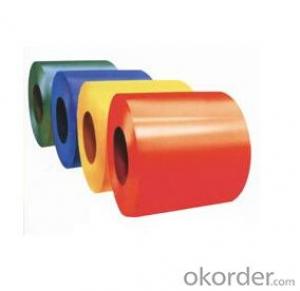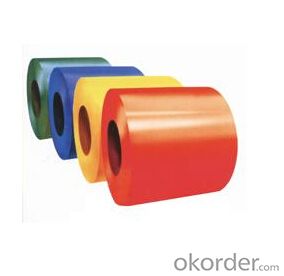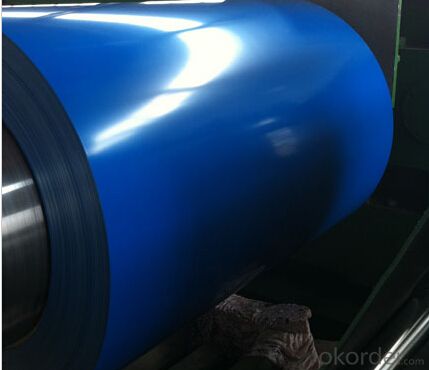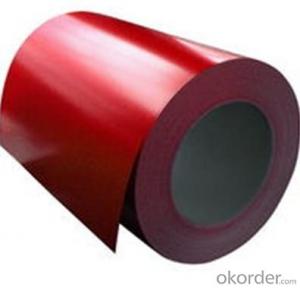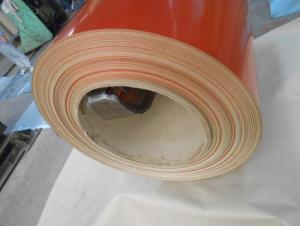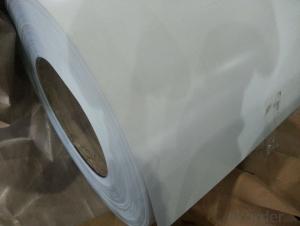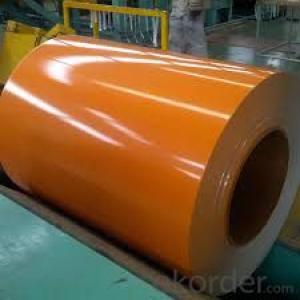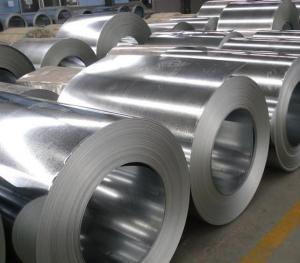Color Coated Steel Coils Based on Gi Coils
- Loading Port:
- Tianjin
- Payment Terms:
- TT OR LC
- Min Order Qty:
- 25 m.t.
- Supply Capability:
- 10000 m.t./month
OKorder Service Pledge
OKorder Financial Service
You Might Also Like
Description.
Surface Treatment:Coated
Technique:Cold Rolled
Standard:JIS
Type:Steel Coil
Special Use:High-Strength Steel Plate
Application:Building Material, Roofing, Household Appliance, E
Export Markets:Global
Additional Info.
Trademark:TOPS
Packing:Standard Export and Seaworthy Packing
Standard:GB/T12754, JIS3312, EN 10169 ASTM A755
Origin:China
Product Description
Color coated Prepainted Galvanized Steel Coils
Grade: SGCC, DX51D, CGCC
Thick: 0.17-0.8, Width: 58-1250mm
Coat: PE, SMP, HDP, PVDF
PPGI PPGL Prepainted Steel coil:
Color coated Prepainted galvanized Steel Coils
Certificate: ISO 9001/14001
The main specification is as belows:
Standards: GB/T12754, JIS3312, EN 10169 ASTM A755
Thickness: 0.14-0.8mm; Width: 914-1250mm
Tolerance: +2/0mm, thickness tolerance: +0.02/-0.02mm (or according to customers' request).
Coating mass: Top; 13-25, Back: 5-10
Coil weight: 5-8 metric tons
Coil DM: I. D: Φ 508m/610mm O. D: Max Φ 1500mm
Coating type: PE, SMP, HDP, PVDF
Common performance of front coating:
(1). Thickness: ≥ 20μ M
(2). Pencil Hardness: 2H
(3). 60° Specular glossiness of coating: >60
(4). 180° Bend: ≤ 3T
(5). Impact: ≥ 9J
(6). Salt Fog Resistant: ≥ 500h
(7). Color difference: <3Δ E
Application
1. Construction: (Outside) workshop, agricultural warehouse, residential precast unit, corrugated roof, wall, rainwater drainage pipe, terrace, retailer booth, roller shutter door
(Inside) door, doorcase, light steel roof structure, folding screen, ceiling, elevator, stairway, vent gutter
2. Electrical appliance: Refrigerator, washer, switch cabinet, instrument cabinet, air conditioning, micro-wave oven, bread maker
3. Furniture: Central heating slice, lampshade, chifforobe, desk, bed, locker, bookshelf
4. Carrying trade: Exterior decoration of auto and train, clapboard, container, isolation lairage, isolation board
5. Others: Writing panel, garbage can, billboard, timekeeper, typewriter, instrument panel, weight sensor, photographic equipment
| NAME | PPGI | GALVANIZED | GALVALUME/ALUZINC |
| CERTIFICATE | ISO9001 | ||
| STANDARD | GB/T-12754 JIS G 3312 EN 10169 ASTM A755 | GB/T-2518 JIS G 3302 EN 10142/10427 ASTM A653 | GB/T-14798 JIS G 3321 EN 10215 ASTM A792 |
| GRADE | SGCC DX51D SGCH CGCD1-CGCD3 CGC340-CGC570 GRADE | SS GRADE33-80 SGCC SGCH SGCD1-SGCD3 SGC340-SGC570 SGCC DX51D | GRADE33-80 SGLCC SGLCD SGLCDD SGLC400-SGLC570 SZACC SZACH SZAC340R |
| MODEL NO | 0.16MM-1.0MM*1250MM OR UNDER | (0.12-1.5)*1250MM OR UNDER | 0.16MM-1.5MM*1250MM OR UNDER |
| TYPE | Steel coil Steel sheets/plates Corrugated steel sheets/plates | Steel coil Steel sheets/plates Corrugated steel sheets/plates | Steel coil Steel sheets/plates Corrugated steel sheets/plates |
| TECHNIQUE | Hot rolled-cold rolled -galvalume /galvanized -PPGI/PPGL | Hot rolled-cold rolled - galvanized | Hot rolled-cold rolled -galvalume /Aluzinc |
| SURFACE TREATMENT | Mini/regular/big/zero spangle, Chromate treatment /chromate-free treatment /untreated unoile/oiled, TENSION LEVELLERT SKIN PASS anti-fingerprint/un-anti-fingerprint, Coating,color | Mini/regular/big/zero spangle, Chromate treatment /chromate-free treatment /untreated unoile/oiled, TENSION LEVELLERT SKIN PASS anti-fingerprint/un-anti-fingerprint, Coating | |
| APPLICATION | Structural use ,roofing, corrugated roofing, commercial use, household appliance, industry, family | ||
| SPECIAL APPLICATION | Wear resistant steel, high- strength - steel plate | ||
FAQ
1.What's your MOQ?
25MT, it is for one container.
2.Do you have QC teams?
Yeah, sure, our QC team is very important, they will keep the quality control for our products.
3. What's your normal delivery time?
Our delivery time about 10-20days for standard sizes, if you have other requirements like hardness and width ,it is about 20-40days. But don't worry ,we also try our best for the delivery time ,because time longer and our cost is higher.
4.Are the products tested before shipping?
Yes, all of our PPGI and GI was qualified before shipping. We test every batch every day.
- Q: Ok, lately I've been taking to making things out of stainless steel chain mallie rings. The problem is that when i make a bracelet or something, the area around the fastener always looks pretty bad. I'm thinking to have a friend who also does chain mallie finish the weave all the way around. This would make it look good but make it impossible to remove.Are there any long term problems with stainless steel on skin? I know some metals will change the color of the skin or make the skin absorb some of the metal. Is this something to worry about with stainless steel?
- Stainless steel contains both nickel and chromium. These two alloys are responsible for most of contact dermatitis in people. Some of my co-workers making steel had such bad reactions to chromium that they had to quit their jobs. Their skin was always inflamed. People don't react to finished stainless steel the same way because the alloys are bonded tightly in the heat treating process. But if you are grinding it and getting the dust on your skin, you could get a contact dermatitis if you are sensitive. I don't think it would absorb into your blood stream or do any long term damage to your skin. If you do get a reaction, you would have to cease your exposure or in a worse case scenario risk getting a body wide reaction like my coworkers. I would not worry about any exposure making rings out of stainless steel. After all, stainless steel is used in sugical implants and most people are fine.
- Q: What are the different methods of slitting steel coils?
- Different methods exist for slitting steel coils, each with unique advantages and limitations. Several common methods include: 1. Rotary Shear Slitting: By employing rotating knives, this method cuts steel coils into narrower strips. It is versatile and efficient, enabling high-speed production and precise slitting. Rotary shear slitting is commonly utilized for thinner gauge materials. 2. Looping Pit Slitting: Steel coils pass through a looping pit in this method, where they are guided and tensioned before being slit. It is suitable for thicker gauge materials and ensures good edge quality. Looping pit slitting accommodates higher coil speeds and heavier coils. 3. Drag Slitting: In this method, the steel coil is dragged over a stationary blade or set of blades to perform the slitting. It is particularly beneficial for difficult-to-slit materials like high-strength steels. Drag slitting yields excellent edge quality and is often utilized for precision slitting applications. 4. Crush Slitting: Pressure is applied to the steel coil in crush slitting to crush and separate it into narrower strips. This cost-effective method is suitable for lower gauge materials but may result in slightly rougher edge quality compared to other methods. 5. Laser Slitting: Laser slitting employs a focused laser beam to cut through the steel coil. It is a highly precise method that offers excellent edge quality and minimal distortion. Laser slitting is commonly employed for high-value and specialty materials. Each method possesses distinct advantages and is suitable for specific applications and material types. The choice of slitting method depends on factors such as material thickness, desired edge quality, production speed requirements, and budget considerations.
- Q: ive made lots of knives but they are dark and not shiny. how do i polish a knife and make it shiny
- If the steel knife is dark and not mirror-shiny, then it is probably carbon steel and not stainless steel. If they are carbon steel, then you cannot polish it to a mirror finish - sorry. If there's any rust on them, you can use a very-fine grit sandpaper to remove. Do not put carbon steel knives in the dishwasher, and dry them thoroughly after hand-washing. For long-term storage (meaning you don't plan to use the knife within the next few weeks), wipe the blade a bit with some mineral oil, then store the blade portion of the knife in a plastic bag.
- Q: What are the different grades of steel coils?
- There are various grades of steel coils available, including low carbon steel, medium carbon steel, high carbon steel, stainless steel, and galvanized steel coils. Each grade has specific properties and applications, making them suitable for different industries and purposes.
- Q: How are steel coils transported?
- Steel coils are typically transported using specialized trailers or railway cars. The coils are securely fastened to prevent movement during transportation and are often stacked to maximize space utilization.
- Q: What are the common methods of protecting steel coils from corrosion during storage?
- To safeguard steel coils from corrosion during storage, there are multiple commonly employed techniques. These methods aim to shield the steel coils from moisture and other environmental factors that could trigger corrosion. 1. VCI (Volatile Corrosion Inhibitor) Packaging: VCI packaging is extensively utilized for steel coil protection. It incorporates VCI materials into the packaging, such as plastic bags or films. These materials emit a vapor that forms a protective layer on the surface of the steel coils, effectively preventing the intrusion of moisture and corrosive agents. 2. Oil Coating: Another widely adopted approach involves applying a thin layer of oil onto the steel coil surface. This oil acts as a barrier, obstructing the contact between the steel and moisture or oxygen. It proves particularly effective for long-term storage or transportation situations. 3. Desiccants: Silica gel packets or similar desiccants can be placed inside the packaging to absorb any trapped moisture. By reducing humidity levels within the packaging, the risk of corrosion is minimized. This method is often combined with VCI packaging or oil coating. 4. Proper Ventilation: Adequate ventilation is crucial to prevent moisture buildup around the steel coils during storage. By facilitating the free circulation of air, humidity levels are reduced, and the formation of condensation, which can lead to corrosion, is prevented. 5. Controlled Environment: Storing steel coils in a controlled environment is an effective corrosion prevention measure. This entails maintaining constant temperature and humidity levels that are unfavorable for corrosion. Temperature and humidity control can be achieved using air conditioning or dehumidification systems. It should be noted that the choice of specific protection methods or combinations thereof depends on various factors, including storage duration, environmental conditions, and specific steel coil requirements. Regular inspections and maintenance are also vital to ensure ongoing corrosion protection.
- Q: I moved into a house which has a steel front door.When I touch the door it feels very cold to the touch in the winter.There is a storm door also and the weather stripping looks good.Cold air from the door is entering the lower level.The house is about 20 yrs old.
- Now a days crime has increased a lot, so we have to take protection and when the protection came to our house there came steel doors. The best ever protection in our houses. Source - www.scoop.it/t/qualitas-steel-doors
- Q: I wasn't expecting much because i knew it was cheap (Trying to avoid high prices) But anyway i cut a few bottles and cans and i noticed the very edge of the blade was starting to bend. I ignored it and tried it on a 3 inch limb, and the whole blade bent sideways where the limb hit it.I heard cold steel was supposed to be top quality and I wanted to know how durable their swords are and if they're worth it. Thanks!
- O.Adequate. First and fundamental it takes coaching and observe to use a katana. There may be a little bit component known as 'system'. You need to to search out an trainer. Except you're a fairly significant man, an O Katana is conveniently too large for you. Weapons of this way were not used for dueling, they have been further anti-cavalry weapons. As a substitute cumbersome for one in the direction of one combat. The cold steel katanas are not very regularly correct varieties of a japanese sword - missing finesse and poorly balanced. They are going to take a beating though and it seems like that's what you probably giving it. Severely, you possibly more often than not a hazard to your self and possible others round you - to search out an teacher.
- Q: What are the different methods of coil slitting for precision cuts?
- Coil slitting is a process used to cut large coils of material, such as steel, into narrower strips with precise dimensions. There are several methods of coil slitting for achieving precision cuts, each offering unique advantages and suitable for different applications. 1. Rotary Shear Slitting: This is the most common method used for coil slitting. It involves passing the coil through rotating circular knives that create two or more strips by shearing the material. The blades can be set at different distances apart to achieve the desired width of the strips. Rotary shear slitting offers high precision and is capable of producing smooth, burr-free edges. 2. Drag Knife Slitting: In this method, a knife with a drag or tangential orientation is used to cut the coil. The knife moves in a controlled path, following the contour of the material and producing accurate cuts. Drag knife slitting is suitable for materials with irregular shapes and is often used in the textile industry for cutting fabrics. 3. Scissor Slitting: Scissor slitting involves the use of two blades that move against each other in a scissor-like motion to cut the coil. This method is commonly used for thinner materials and provides excellent control over the cutting process. Scissor slitting is ideal for achieving precise cuts in materials that are prone to deformation or wrinkling. 4. Razor Slitting: Razor slitting utilizes a single razor blade or multiple razor blades in a holder to cut the coil. The blade(s) are positioned perpendicular to the material and slice through it. This method is particularly effective for cutting stretchy or delicate materials, such as plastic films or paper, as it minimizes the risk of tearing or deforming the material. 5. Crush Cutting: Crush cutting involves using a hardened steel roller or an anvil against a softer material, such as foam or rubber, to cut the coil. The pressure applied causes the material to deform and split along the desired cutting line. Crush cutting is suitable for materials that are difficult to cut with sharp blades and can produce precise, clean cuts. Overall, the choice of coil slitting method depends on the material being cut, the desired precision, and other requirements of the specific application. Each method offers its own benefits and can be tailored to meet specific cutting needs, ensuring accurate and efficient coil slitting processes.
- Q: How are steel coils used in the production of agricultural machinery?
- Steel coils are used in the production of agricultural machinery as they are a key component in the manufacturing of various parts. These coils are used to create durable and strong components such as frames, chassis, and structural supports, which are essential for the heavy-duty requirements of agricultural machinery. The steel coils are shaped, cut, and welded to create these components, ensuring the machinery can withstand the demanding conditions of farming operations.
Send your message to us
Color Coated Steel Coils Based on Gi Coils
- Loading Port:
- Tianjin
- Payment Terms:
- TT OR LC
- Min Order Qty:
- 25 m.t.
- Supply Capability:
- 10000 m.t./month
OKorder Service Pledge
OKorder Financial Service
Similar products
Hot products
Hot Searches
Related keywords
